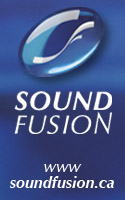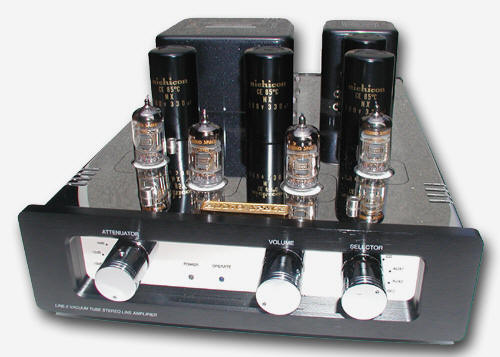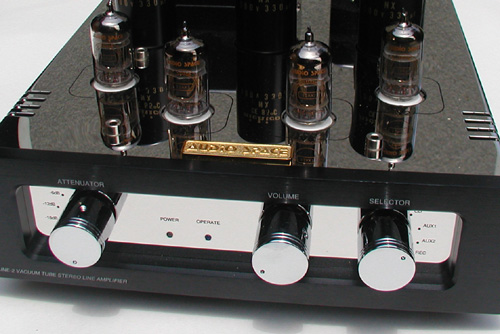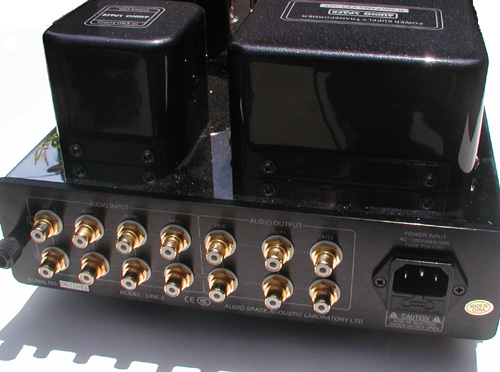
You are reading the older HTML site
Positive Feedback
ISSUE
28
audio space
Line 2 linestage
as reviewed by Steve Lefkowicz

|
STEVE LEFKOWICZ'S SYSTEM
LOUDSPEAKERS
ELECTRONICS
SOURCES
CABLES
ACCESSORIES
|
I am not one to get involved in the constant switching around of "reference" components in my system, nor am I one to join the "hot product of the month" club, buying whatever new big thing comes along. In fact, since I came out of my self-imposed audio "retirement" back in 1998, I have only bought three new pieces of equipment for my system. I bought the Marantz SA8260 SACD player (to replace an AMC CD8), though I never reviewed it for either Listener or PFO. I also added the Antique Sound Labs MG-SI15DT-S as an additional (though principal) amplifier, also without ever offering up a formal review other than a brief comment in Listener. Oh, and I finally replaced the Talisman S cartridge I used for years with a wonderful Dynavector 19A.
Why do I mention this here and now? I want to get the point across that although I do get to review and play with a lot of very good products, I rarely feel the need to replace anything in my system. I like the way my system sounds. I like the way it works. I have no desire to spend money (even at industry accommodation pricing) unless I am getting a substantial improvement in my system.
I also, having a self-imposed stance as the "budget equipment guy," don't often find products that qualify as "budget" that also make an actual, significant improvement in my system. Sure I've had lots of fine gear in for review that I would heartily recommend to even my closest friends if they were looking to buy something new. However, none of these products were that much better than what I already have to make me want to spend the money to replace anything.
There has been one big exception, one product that I reviewed a few years ago that did make me think it was time to seriously think about upgrading a part of my system. That product was the Cary SLP-88 preamp (see review in Issue 6). The active linestage was not just an improvement over the PS Audio 4H (used only in passive mode) that I have used for about 18 years, but was a serious improvement of the most fundamental kind. There was not a single area of music reproduction that wasn't bettered with the Cary in use. However, rather than decide then and there to buy the Cary, my thought process was more in terms of ...if this is so good for $2000, I have to find out what else is out there that still falls into my ‘budget' price point.
I have arbitrarily set that price point to be under $3000.
What does that have to do with the Audio Space Line 2 under review here? Well, now that I am back from my somewhat forced two-and-a-half year leave of absence (recovering from an automobile accident), I am now getting back to finding out what else is out there. The Audio Space Line 2 is the first of what I hope to be a series of reviews of similarly priced, mostly tube based, linestages.
Audio Space (the company) is another of the ever-growing number of Chinese electronics manufacturers now selling in North America. Though they are relatively new to the US market, this Hong Kong based company has been around since the early 1990s. The US distributor is Gini Systems of Pomona, CA (www.gini.com).
The Line 2 is a fairly minimalist linestage that fits into a nice compact (9.8"W x 13.2"D × 6"H) case. I like the narrow design, as it allows me to fit it sideways on my rack, making switching out cables much easier. Unless you are either a reviewer or a cable hound, that might not matter much to you. The unit weighs about 17.5 pounds, most of which seems to be in the case and the amply sized transformers (where the weight should be). Single ended RCA connections for four inputs and dual outputs, plus a tape loop (in and out) is plenty for most systems, including mine. The tube compliment is two 12AX7 and two 12AU7 and the supplied tubes have the Audio Space name on them.
The three control knobs on the front are nicely laid out. There is a very smooth volume control (not a stepped attenuator), a source selector, and a six-position gain selector ranging from 0dB to mute in 6 dB steps (0, -6, -12, -18, -24 and mute). I am not sure why, but throughout my review, I always found the Line 2 to sound best with the attenuator set to –6dB. But I think that might be related more to how it mates up with my other equipment, and certainly can't say that the same will be true for you.

The case rests on four cylindrical feet, but there is a small hemispherical soft footer underneath each. Though smaller and harder than something like a Bright Star IsoNode, they seemed very effective. I found no further improvement using either IsoNodes or even the very expensive Feet of Silence.
Overall, construction quality, both inside and out, seems to be to a very high standard. I saw no indication of any cost cutting measures, or anything other than very fine workmanship.
I used both the stock power cord (as I usually do for reviews) and also tried an inexpensive Cardas Twinlink power cord. Can't really say I heard much difference between the two.

During the listening sessions, in addition to all the equipment listed in the sidebar, I also made use of the new Funk Firm turntable with a classic Denon 103 cartridge (playing through the phono section of my PS preamp), and the remarkable Direct Acoustics Silent Speakers. Near the end of the review period I also just started using the new Marantz SA8001 two-channel SACD player, which I received as a replacement for my aging SA8260. Full reviews of all these products are in the works.
One last story before I get into describing the Line 2. When dear Editor Dave Clark handed the box over to me, he made some comments about how in his brief listening session he thought the unit was absolutely phenomenal and a close match for his new and much more expensive Cary. Now understand, Dave Clark has one of the most consistently dry senses of humor of anyone I've ever met. It is hard to ever tell when he's serious or joking, as his expression never changes no matter how outrageous his comments. Also, please remember that this is only the second review I've done since recovering from my auto accident. So where did that send my mind? Was he serious? Why would he tip me off before I heard the unit? Was he joking and maybe the Line 2 was actually terrible? Was he testing me, to see if my post concussion syndrome was really as cleared up as I seem to feel it is? Was he testing me to see if I would dare send him a review disagreeing with him? Actually, he knows I'd have no problem with that, as I hear what I hear, and like what I like. Anyway, the whole thing had me curious about what I would hear when I finally sat to listen.
On first listen after installing the Line 2, I was initially struck with how quiet the Line 2 was. With the attenuator at 0dB and the volume knob all the way up, there was, much to my surprise, no noise through the speakers at all. This was actually quieter than my PS Audio solid-state preamp even in passive mode. I never expected that from a tube linestage.
Whenever we listen to something for the first time, we naturally have an immediate first impression. Sometimes that first impression turns out to be pretty accurate, and other times we find ourselves realizing that first impressions can be pretty far off base.
My first impression (listening to the SACD of David Johansen and the Harry Smiths) was, simply put, "Wow!"
What caused that reaction was how the first tune (James Alley Blues) just popped out of a totally silent and empty background, and had such fullness, such a feeling of body, weight, size and naturalness that it had me fairly well mesmerized. After that track finished, and I listened to the third track (Delia) with more of the same feeling. There was an immense sense of space and body to the music. This was a new level of musical enjoyment for my system. I ended up listening to the entire SACD, instead of just the couple tracks I originally planned on.
I do have a few favorite disks I use for initial listening sessions. Certain disks, though not audiophile favorites by any means, that give me a very good quick check on whether a new piece of gear gets certain things right, or how it stacks up against other pieces I might be comparing to. I quickly ran through a few of these; Blood Sweat & Tears (SACD), Ingrid Lucia and the Flying Neutrinos Hotel Child (CD), Pink Floyd's Wish You Were Here (re-mastered CD), Katherine Whalen's Jazz Squad, a few Julie London and Peggy Lee CDs along with the aforementioned David Johansen. These let me check tonality, dynamics, detail, pace, timing, soundstaging, and general musicality pretty quickly. I sailed through a few cuts from each of these CDs and still just kept thinking "Wow!"
I then switched to LPs for a bit.
 I also, of course, have my short list of LPs that I run through for an
additional quick check on system changes. This list includes (though not
limited too); Tom Waits soundtrack to the movie One from the Heart,
The Classic Records reissues of Genesis' Nursery Cryme,
Selling England by the Pound and The Lamb Lies Down on Broadway,
an very early pressing of Rickie Lee Jones's first LP, a few early King
Crimson LPs (mostly Lizard, Islands, and Larks Tongues
in Aspic), the Roches' first LP and the McGarrigle Sisters' first
LP.
I also, of course, have my short list of LPs that I run through for an
additional quick check on system changes. This list includes (though not
limited too); Tom Waits soundtrack to the movie One from the Heart,
The Classic Records reissues of Genesis' Nursery Cryme,
Selling England by the Pound and The Lamb Lies Down on Broadway,
an very early pressing of Rickie Lee Jones's first LP, a few early King
Crimson LPs (mostly Lizard, Islands, and Larks Tongues
in Aspic), the Roches' first LP and the McGarrigle Sisters' first
LP.
I planned on listening to a few minutes of each of these LPs, but soon realized it was late afternoon and I had been listening to at least an entire side of each, if not the entire LP. I did swap speakers (Sound Dynamics 300ti and Direct Acoustics Silent Speakers) and amplifiers (B&K ST140 and Antique Sound Labs MG-SI15DT-S) a few times, but other than that, I had spent the entire day getting nothing else accomplished. I had just sat there, spinning disks and listening…
…and enjoying!
Regardless of what I played, or what source I used, there was a tremendous sense of naturalness, ease and effortlessness that made everything sound just more real than I generally expect from my system. Vocals weren't just well done, but had that breathiness, and sense of coming from a real body that we expect from a good hi-fi system. Vocals were reproduced such that you could hear, not just what the vocalist was signing, but what they were feeling too. You could tell that Katherine Whalen was clearly enjoying the selection of songs on her Jazz Squad CD, and you could hear the joy in her voice. Ingrid Lucia was clearly having a fun time playing with the words and phrases on the Hotel Child disk. Rickie Lee Jones was all attitude, but here it also sounded sincere, not just an act.
 The instruments playing along were all also extremely well done.
Listening to the various prog rock LPs mentioned earlier, with their
dense instrumentation, it was clear that this preamp was letting
everything come through with little if any alteration or damage to the
signal. I have listened to Larks Tongues in Aspic many hundreds
of times since I bought that LP while in high school (around 1974?) and
yet, with the Audio Space Line 2, I was able to pick out a small
percussion line buried deep in the mix that I simply had never heard
before. The extreme level of detail coming through such an otherwise
full and dense sound was quite remarkable. There was nothing lean or
analytic about the sound at all.
The instruments playing along were all also extremely well done.
Listening to the various prog rock LPs mentioned earlier, with their
dense instrumentation, it was clear that this preamp was letting
everything come through with little if any alteration or damage to the
signal. I have listened to Larks Tongues in Aspic many hundreds
of times since I bought that LP while in high school (around 1974?) and
yet, with the Audio Space Line 2, I was able to pick out a small
percussion line buried deep in the mix that I simply had never heard
before. The extreme level of detail coming through such an otherwise
full and dense sound was quite remarkable. There was nothing lean or
analytic about the sound at all.
The Line 2 did not compress dynamics, or maybe I should say it compressed dynamics less than any other preamp I have used. Brass instruments especially, had an explosive sense of dynamics that could be quite startling at times. Same with percussion instruments, except as noted in the Silent Speaker review in issue 26, where the limitations were clearly due to the speakers.
At first, I thought bass instruments were emphasized a little too much, almost like an old-fashioned bass boost control on mass-market receivers and integrated amps. There was clearly more bass than I usually hear from my system. However, the more I listened, especially to normal recordings with real bass lines (as opposed to bass spectaculars designed to show off the bass capabilities of a system), I came to view this as being more lifelike and real. It wasn't the bass that was boosted up in volume (measurements with Stereophile Test CD2 and a calibrated Radio Shack meter showed no bass boost compared to other preamps I had in house) as much as it somehow carried more weight, more power, and more definition. I think this is closer to the way the bass lines were on the recording, and that my other preamps were limiting or reducing the bass. The Line 2 got it right.
I find preamps and linestages generally easy to review but difficult to write up. How much of what I'm hearing is really purely because of the preamp, and how much is the overall interaction of the piece in my system connected to everything else? A preamp (or linestage) can't improve the incoming signal, and can't add anything positive to the signal. All we can really hope for is that it neither takes anything good away, nor adds anything bad. That is one reason I have used a passive line section for so many years. It would seem to just make sense that a passive unit would do the least to the signal as it passes through. But then again I come back to the basic fact that for me, all the best systems I have heard over the years had high quality active linestages, and usually (though not always) tube linestages.
So again, like when I reviewed the Cary SLP-88 a few years ago, though it seems like the audio Space adds dynamics, clarity, purity, and absolute killer bass, I know that it isn't. It's just not limiting or distorting these things the way my PS Audio apparently does. It could be that designing an honest to goodness high quality linestage is more difficult than most of us think, and maybe that is why most active linestages I have tried over the years failed to impress me enough to have them replace the PS Audio. Maybe it's just that the designers of linestages have learned enough over the last fifteen years or so to where they can now design great units that can sell for a reasonable price. Maybe the influx of good sounding, well built gear from China has pushed manufacturers everywhere to get on the ball and build better sounding and better-built equipment at a more affordable price?
Maybe…
Getting back to the Line 2, after several months of daily listening to all kids of music from SACD, CD, and LP, I remained thoroughly impressed every time I listened. I would be interested in comparing this to Dave's new Cary even though that unit costs about three times the price of the Audio Space. I find it hard to see where there is too much room for further improvement.
Well since the Cary SLP-88 that I reviewed back in 2003 is of the market, which leaves the idea of comparing the Audio Space Line 2 somewhat out of the question. I can say that I do remember that at the end of the review period with the Cary, though I thoroughly enjoyed it and missed it, I was more interested in trying additional competing preamps and linestages than I was in buying the Cary. I was also, not disappointed or let down going back to using my PS Audio, though I did then understand its limitations better than I had before using the Cary. This time around, with the Audio Space Line 2, that's not quite the case. I am seriously looking at replacing the PS Audio now, as compared to the Audio Space, its limitation are now just too obvious. Over the next year or so I will be reviewing more preamps and linestages, to decide what I will buy, but as of right now, I expect the Audio Space to remain at or near the top of the list. It is a superb unit from every standpoint, sound quality, design, construction, and at its price, a bargain too. It is very highly recommended. Steve Lefkowicz
Audio
Space Line 2
Price:
$2495
Specifications:
-
Frequency Response: 5Hz - 100KHz
-
Output Impedance: <2.5K
-
Output Level: 2-28V
-
Tube Complement: 2 x 12AX7, 2 x 12AU7
-
Input: 4 groups of RCA
-
Output: 3 groups of RCA
-
Dimensions: 9.8"(W) x 13.2"(D) × 6"(H)
-
Weight: 8 kg
Gini Systems
web address:
www.gini.com
Canadian Distributor
web address:
www.charismaaudio.com
